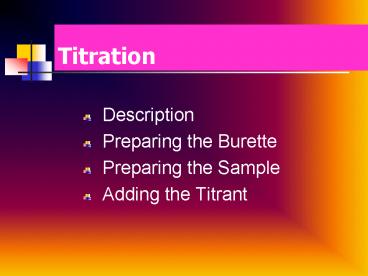Titration - PowerPoint PPT Presentation
1 / 24
Title:
Titration
Description:
The meniscus does not need to be on the 0.00 mL mark to begin the titration; ... Determine the volume by reading from the bottom of the meniscus at eye level. ... – PowerPoint PPT presentation
Number of Views:130
Avg rating:3.0/5.0
Title: Titration
1
Titration
- Description
- Preparing the Burette
- Preparing the Sample
- Adding the Titrant
2
Titration
- In a titration two reagents are mixed, one with a
known concentration and one with an unknown
concentration. - This is some way to indicate when the two
reagents have reacted essentially completely, and
at the end of the titration the unknown
solutions concentration can be calculated.
3
Titration
- Typically, one reagent is a solution and is
added from a burette. - This solution from the burette is added to a
flask that contains either a measured volume of
a solution or a weighed quantity of solid that
has been dissolved. - The burette has graduations that are used to
read the volume of titrant added to that flask.
4
Preparing the Burette
- Rinse a clean burette several times with
- 5 mL portions of the titrant ( the solution
that will be added to the flask ).
5
Preparing the burette
- Allow the titrant to drain through the burette
stopcock so that the tip gets rinsed with titrant
as well.
6
Video Draining the burette
7
Preparing the Burette
- Discard the rinse solution in a waste beaker.
Clamp the burette into place, and fill it with
the titrant.
8
Video Filling the burette
9
Preparing the Burette
- Remove air bubbles from the tip of the burette
and the stopcock by draining several mililiters
of titrant. - Dispose of the drained titrant in a waste beaker.
10
Preparing the Burette
- Close-up of the burette tip.
- Note the large air bubble that must be removed.
11
Video How to remove air bubbles
12
Preparing the Burette
- Make sure the volume reading in the burette is at
the 0.00 mL mark or below - The meniscus does not need to be on the 0.00 mL
mark to begin the titration more reproducible
results usually occur when the initial reading is
not 0.00 mL.
13
Preparing the Burette
- Record the volume reading on the burette.
Determine the volume by reading from the bottom
of the meniscus at eye level. - All certain digits (markings on the glassware...)
and one uncertain digit (an estimate of the
fraction between the markings...) should be
recorded.
14
Preparing the Sample
- The sample to be titrated is a solution
- pipette the desired volume into an Erlenmeyer
flask. - Record the exact volume transferred. Dilute the
sample with a small portion of distilled water
(about 10 to 20 mL).
15
Preparing the Sample
- The sample to be titrated is a solid
- weigh the desired mass, add the solid to an
Erlenmeyer flask, and dissolve it in distilled
water. - Be sure to record the exact mass of sample used.
16
Preparing the Sample
- Change in color of a chemical indicator is
usually used to signal the endpoint of the
titration. If necessary, add a few drops of an
appropriate indicator to the solution.
17
Indicator
- An indicator changes colour according to the pH.
- Phenolphthalein and methyl orange are two common
indicators.
colourless red
red yellow
18
Adding the Titrant
- The rate of addition of titrant is determined by
the rate at which the indicator changes color. - At the beginning of the titration, titrant may be
added quickly since the indicator color
disappears rapidly. - When the color persists for longer periods of
time, add titrant more slowly (a drop or less at
a time).
19
Video Addition of Titrant
20
Adding the Titrant
- Be sure to mix the two reactant solutions
thoroughly by swirling the flask as the titrant
is added.
21
Adding the titrant
- If solution splashes up to the side of the flask,
you can use distilled water to wash it back into
the solution. - Placing the flask on a piece of white paper will
often help you observe the first appearance of
color change.
22
Determining the Endpoint
approximately at endpoint (very faint pink tinge)
- Flask before endpoint
after endpoint (overshot)
23
Determining the Endpoint
- Remember to record the volume reading of the
burette when you have reached the endpoint.
24
-End-

